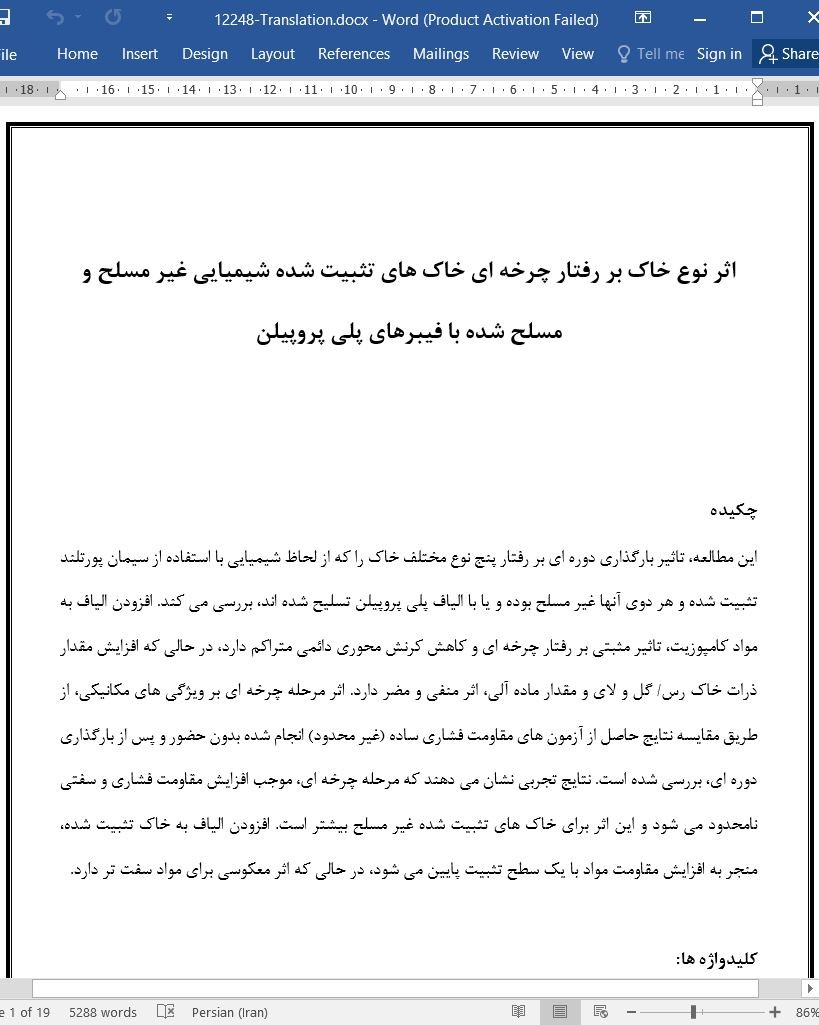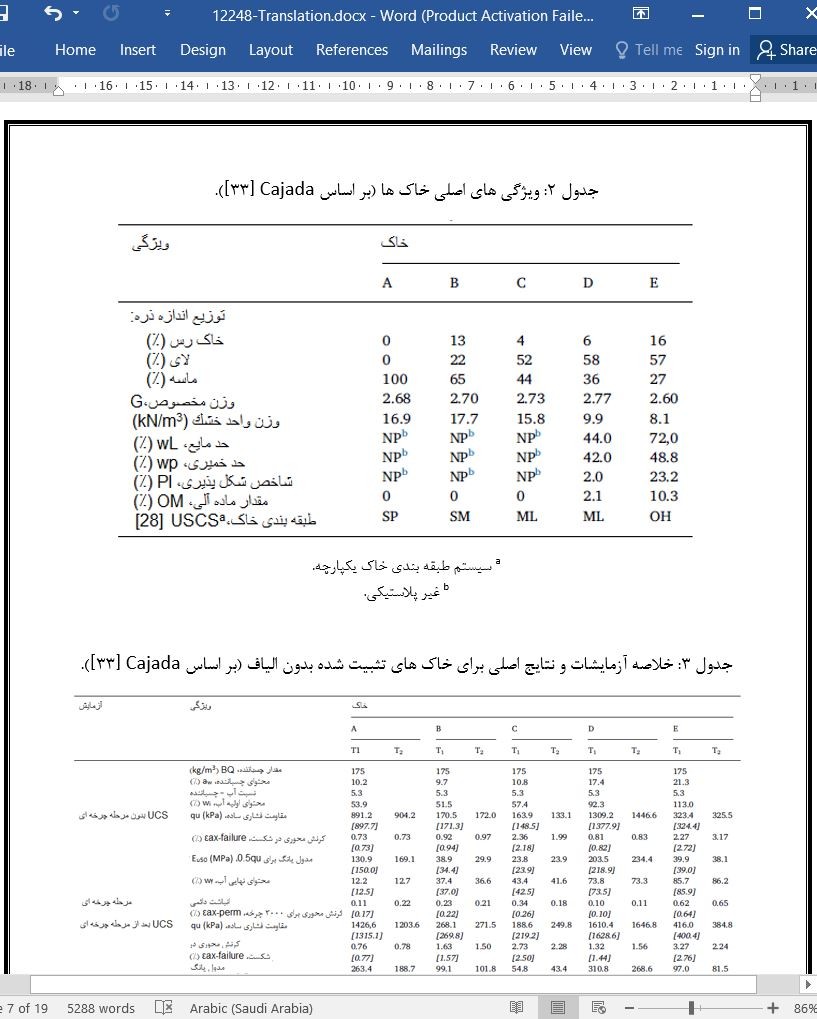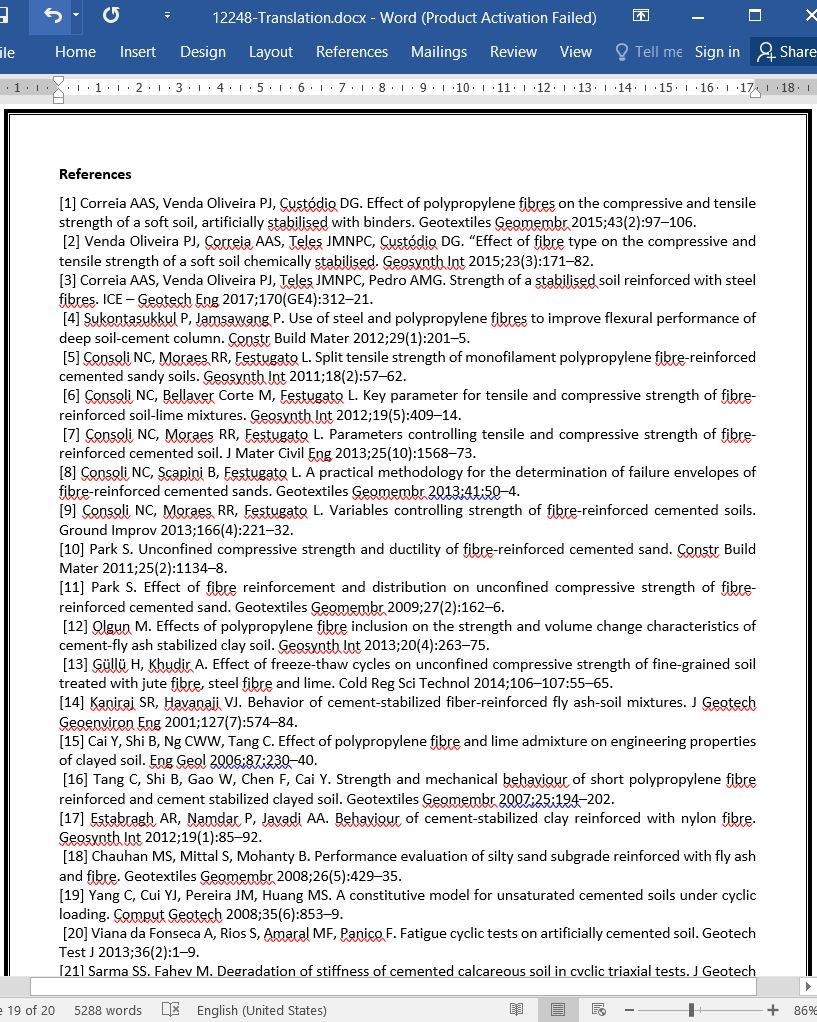
اثر نوع خاک بر رفتار چرخه ای خاک های تثبیت شده شیمیایی غیر مسلح
چکیده
این مطالعه، تاثیر بارگذاری دوره ای بر رفتار پنج نوع مختلف خاک را که از لحاظ شیمیایی با استفاده از سیمان پورتلند تثبیت شده و هر دوی آنها غیر مسلح بوده و یا با الیاف پلی پروپیلن تسلیح شده اند، بررسی می کند. افزودن الیاف به مواد کامپوزیت، تاثیر مثبتی بر رفتار چرخه ای و کاهش کرنش محوری دائمی متراکم دارد، در حالی که افزایش مقدار ذرات خاک رس/ گل و لای و مقدار ماده آلی، اثر منفی و مضر دارد. اثر مرحله چرخه ای بر ویژگی های مکانیکی، از طریق مقایسه نتایج حاصل از آزمون های مقاومت فشاری ساده (غیر محدود) انجام شده بدون حضور و پس از بارگذاری دوره ای، بررسی شده است. نتایج تجربی نشان می دهند که مرحله چرخه ای، موجب افزایش مقاومت فشاری و سفتی نامحدود می شود و این اثر برای خاک های تثبیت شده غیر مسلح بیشتر است. افزودن الیاف به خاک تثبیت شده، منجر به افزایش مقاومت مواد با یک سطح تثبیت پایین می شود، در حالی که اثر معکوسی برای مواد سفت تر دارد.
1. مقدمه
در طی چند سال گذشته، مطالعات متعددی در مورد افزودن فیبرهای مصنوعی و فولادی کوتاه [17-1] در مخلوط خاک - بیندر (چسباننده) - آب به منظور بهبود ویژگی های مکانیکی خاک های تثبیت شده و عمدتا برای افزایش قابلیت شکل پذیری و ارائه استحکام کششی و خمشی، انجام شده است. به طور كلي، آثار منتشر شده مبتنی بر نتايج آزمون هاي مونوتونيك در اين زمينه نشان مي دهند كه استفاده از الیاف كوتاه، موجب كاهش شکنندگی و افزايش استحکام پس از بیشینه مواد كامپوزيتي مي شود. در مورد اثرات تسلیح با الیاف بر روی استحکام، نتایج به طور کامل همگرا نیستند، زیرا به نظر می رسد که به نوع الیاف، محتوای چسباننده و حتی نوع آزمون مورد استفاده برای ارزیابی استحکام فشاری و/ یا کششی بستگی دارد [1-3].
4. نتیجه گیری
با توجه به نتایج آزمایشات مونوتونیک UCS انجام شده بدون و پس از آزمایشات بارگذاری دوره ای (متوسط سطح تنش انحرافی 0.55xqu-failure، فرکانس 0.25 هرتز، دامنه 7.5٪± × qu-max بالای 3000 چرخه بار) که بر روی پنج خاک مختلف تثبیت شده با یک سیمان پورتلند (نوع I 42.5 R) و غیر مسلح یا مسلح شده با الیاف پلی پروپیلن انجام شده اند، مشاهدات و نتیجه گیری های زیر را می توان ارائه کرد:
i) تکامل کرنش محوری دائمی انباشته، نشان دهنده یک افزایش شدید در ابتدای مرحله چرخه ای و به دنبال آن یک کاهش در نرخ کرنش با افزایش تعداد چرخه های بار است. این رفتار نشانه ای از تخریب تدریجی ماتریس خاک-چسباننده-آب است.
Abstract
This work examines the effect of cyclic loading on the behaviour of five different soils chemically stabilized with Portland cement that were both non-reinforced and reinforced with polypropylene fibres. The inclusion of fibres in the composite material has a positive effect on the cyclic behaviour, decreasing the accumulated permanent axial strain, while the increase in the amount of clay/silt particles and the organic matter content has a detrimental effect. The effect of the cyclic stage on the mechanical characteristics is evaluated comparing the results of unconfined compression strength tests carried out without and after the cyclic loading. The experimental results show that the cyclic stage induces an increase in the unconfined compressive strength and stiffness and this effect is greater for the unreinforced stabilized soils. The inclusion of fibres in the stabilized soil tends to increase the strength for materials with a low level of stabilization, having the opposite effect for stiffer materials.
1. Introduction
During the last few years several studies have been carried out concerning the inclusion of short synthetic and steel fibres [1–17] in soil-binder-water mixtures to improve the mechanical characteristics of stabilized soils, mainly to increase the ductility and to confer some tensile and flexural strength. In general the works published about this issue, based on the results of monotonic tests, show that the use of short fibres promotes a decrease in the brittleness and increases the post peak strength of the composite materials. In terms of the effects of the fibrereinforcement on the strength, the results are not totally convergent, since they seem to depend on the type of fibre, the binder content and even the type of test used to evaluate the compressive and/or tensile strength [1–3].
4. Conclusions
Considering the results of the monotonic UCS tests performed without and after the cyclic loading tests (average deviatoric stress level of 0.55xqu-failure, frequency of 0.25 Hz, amplitude of ± 7.5%×qu-max up to 3000 load cycles) carried out on five different soils stabilized with a Portland cement (Type I 42.5 R) and unreinforced or reinforced with polypropylene fibres, the following observations can be made and conclusions drawn: i) The evolution of the permanent cumulative axial strain shows a sharp increase at the beginning of the cyclic stage followed by a decrease in the strain rate with the increment of the number of load cycles. This behaviour is a symptom of the progressive destructuration of the-soil-binder-water matrix.
چکیده
1. مقدمه
2. شرح کار تجربی
2.1. مشخصات خاک های مورد مطالعه
2.2. ویژگی های چسباننده ها و الیاف
2.3. آماده سازی و آزمایش نمونه
3. نتایج و بحث
3.1. رفتار چرخه ای
3.2. رفتار تنش-کرنش
3.3. ویژگی های مکانیکی
4. نتیجه گیری
منابع
ABSTRACT
1. Introduction
2. Description of the experimental work
2.1. Characteristics of the soils studied
2.2. Characteristics of the binders and fibres
2.3. Specimen preparation and testing
3. Results and discussion
3.1. Cyclic behaviour
3.2. Stress-strain behaviour
3.3. Mechanical characteristics
4. Conclusions
References
- ترجمه فارسی مقاله با فرمت ورد (word) با قابلیت ویرایش، بدون آرم سایت ای ترجمه
- ترجمه فارسی مقاله با فرمت pdf، بدون آرم سایت ای ترجمه



